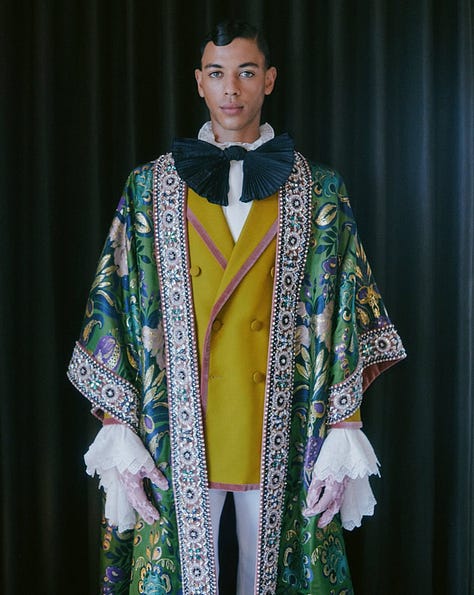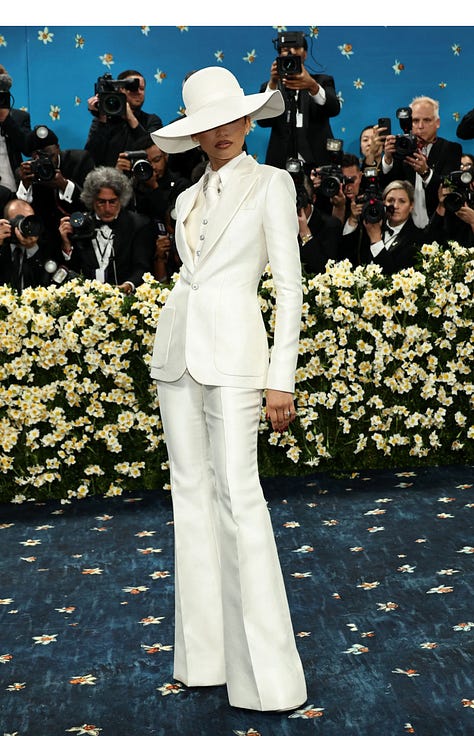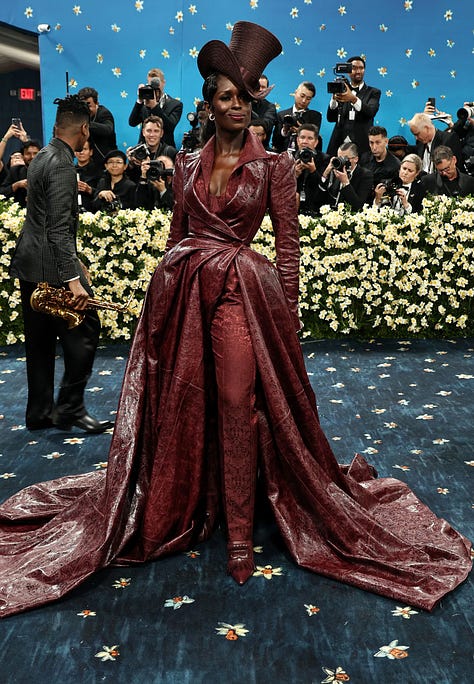Stitching Meaning: Reflections on the Met Gala
A Meditation on Dandyism, Black Legacy, and the Radical Elegance of Being
I originally set out to write about my thoughts on the fashions that graced the red carpet of this year’s Met Gala whose theme was “Superfine: Tailoring Black Style. This was also the title of the Costume Institute's spring exhibition, which explored the importance of tailoring in shaping Black identities, particularly through the lens of Black dandyism. The accompanying dress code for the gala was Tailored for You which encouraged guests to interpret the theme of menswear and tailoring in a personal way. Superfine: Tailoring Black Style presents a cultural and historical examination of Black style from the 18th century to the present through an exploration of the concept of dandyism.” Source: The Metropolitan Museum of Art
My thoughts as I extemporaneously shared them in real time to a very close friend who lent me their listening ears, spilled from my mind onto a somewhat emotionally driven diatribe of a text at some ungodly hour yesterday morning.
At 5:33 a.m. Tuesday, May 6, 2025, my text below read: (Please note that I am transcribing it as it reads on text, without corrections in spelling, grammar or punctuation as I wish for my words to remain as authentic as possible.)
“the whole concept of dandyism has its roots in black resistance and self-definition. long before it was a ‘fashion’ aesthetic it was a radical act: black men and women, denied dignity and respect asserted it anyway through elegance, poise, and immaculate dress form. i thought about that as i watched last night unfold—this pageantry of fabric, fame, and feigned fantasy. i watched the gowns (why were there gowns en flou? why the soft languid silhouettes?) sweep by as the commentaries spun. i kept asking one thing: where were their flowers? where was the tribute to those who defined beauty, through resistance, who shaped freedom, who walked in grace when the world tried to strip them bare? last night wasn’t a tribute—it was a cosplay. it was a night of pretend. a costume convention for the wealthy, like a high-fashion comic-con where attendees dressed in the idea of legacy without shouldering any of its weight. they played in the aesthetics of old worlds, mythical gardens, and imagined royalty, while ignoring the very real lineages that made their performances possible. dandyism, wasn’t born in parisian ateliers—it was sharpened on the streets of harlem, its roots tracing back to africa, assembled by hands and minds that knew both silk and struggle. where was the mention of the sapeurs? the congolese dandies who turned colonizer dress codes into tools of power and poetry? who walked through the wreckage of imperialism draped in bold colors and impeccable tailoring, reclaiming dignity and self-proclaimed sovereignty? their dress was an act of defiance - it was the idea of claiming dignity, identity, and power without waiting for external validation.the sapeurs are a huge part of the blueprint. yet their absence spoke louder than any floral appliqué or exaggerated silhouette. but instead of honoring that truth, the room shimmered with amnesia. what a missed opportunity.”
To reconcile with my emotions, I posted a short blurb on Instagram that same day:
“There’s so much to unpack from last night’s Met Gala—and some of it was hard to take in. For over fifteen years, my work has centered on amplifying one woman’s hidden legacy, one rooted in a collective and shared revolution. Elizabeth Keckley’s story of resistance was shared and carried by many—like Frederick Douglass—whose legacies were present, palpable, and within reach last night. And yet, the moment lacked the depth, context, and recognition these way pavers deserve. Was last night a success? That depends on how we define success. The institution raised a staggering $31 million—a record in its 77-year history. But once again, it came at the cost of Black people’s stories, labor, and legacy—blurred, dimmed, and folded into spectacle.”
It is now Wednesday, the 7th of May, and I am here at home, sitting and writing this— contemplating whether I should extrapolate on this further, yet everything about doing it feels wrong, and here’s why: I have no right to offer my opinion. I have no right to examine the choices with a fine toothed comb. I have no right to usurp the expressions those individuals chose to evoke through the fibers. I have no right to decide who adhered to the theme and who did not because those were not my stories to tell, it was theirs.
But maybe that’s the hardest part of it all—holding space for many truths at once. I set out, naively perhaps, to make sense of the fashion, to track lines and threads and silhouettes back to a larger cultural lineage I know and love, to celebrate what I thought should be celebrated and critique what felt off. But who am I to assign meaning—or lack thereof—to someone else’s act of adornment? What I see as absence might, to someone else, be an act of homage too subtle for my eyes. What I read as costume might be someone’s lived memory or personal reckoning.
Each person who walked that carpet carried a world on their shoulders, whether consciously or not. Their choices—however curated, however performative, however commercial—were still choices rooted in something. Maybe joy. Maybe grief. Maybe fashion history. Maybe personal style. Maybe ancestral memory. Maybe nothing more than a desire to feel beautiful for a night.
And that matters.
All their stories matter.
And I have no right to declare which story holds more weight, which expression is more “true” or more aligned with the theme. The multiplicity of Black style, of Black life, is not something that can be easily codified or measured. It's expansive, contradictory, improvisational, and profoundly personal. It contains both the flourish of a brocade jacket and the quiet rebellion of a crisp white tee.
What I do know is that my own discomfort, my critique, my longing for deeper recognition for people like Elizabeth Keckley and Frederick Douglass—these too are part of the story. But they’re not the whole story. A single thread in a much larger fabric—one sewn long ago by hands like Keckley’s and voices like Douglass’s, whose truths continue to echo in us all.
So today, instead of indicting, I’m choosing to reflect. To listen more. To stay in conversation with the living, breathing continuum that is Black expression. To learn. Because whether stitched in silk or shouted in silence, these narratives all deserve room to unfold on their own terms—not mine. Not ever.
And through all of this—my questioning, my stumbling, my wanting—my dear friend listened. He listened with great attention to my naïveté, my vulnerability, and yes, my ignorance. He didn’t rush to correct or critique. He didn’t offer easy answers. He simply held space—a rare and quiet kind of generosity in a world so eager to react. I realized he was the living proof of a Dandy.
He is the epitome of cultivated vitality—a man who lives fully and intentionally. A world-class athlete with a body honed by discipline and years of performance at the highest level, he moves with the easy grace of someone equally at home sprinting across a track or running a marathon in the harsh terrains in Africa, climbing a mountain as high as Kilimanjaro, diving into open water in the cold lakes of Canada. But there’s more than muscle behind the motion.
Off the field, he's a writer of uncommon depth—his prose blends intellectual rigor with poetic flair, often illuminating intersections between sport, identity, and the human spirit. He writes like he moves: with precision, passion, and rhythm.
As a culture bearer, he doesn’t just reflect his heritage—he carries it forward. Whether through spoken word, essays, or curating gatherings, he transmits history with reverence and innovation. People listen not just because of what he says, but because of how he says it—rooted, resonant, alive.
A connoisseur of style, he wears clothes the way a jazz musician plays notes: classic with an edge, tradition twisted just enough to surprise. Whether in a tailored linen suit and silk polka dot shirt, or a vintage velvet track suit and sneakers, whether donning a Moroccan djellaba with Jill Sander oxfords and a pair of Phillip Lim trousers, he turns sidewalks into runways without ever looking like he’s trying. Style in form. Style in function.
He’s an art lover in the most expansive sense—not just with paintings and sculpture, but movement, architecture, sound. His home is filled with pieces that have stories: a richly saturated handwoven African textile framed like a painting, a rare Japanese woodblock, a statue of Buddha from a monastery in Tibet, a mask from Benin, sacred Myrrh burning in a clay pot. Each item is a conversation, and he knows how to have it. The walls hum with a curated collection of vinyl—first pressings, rare jazz imports, soul classics—shelved beside books that span Black history, design, poetry, art, philosophy. His space is as layered as his mind: cultivated, curious, and alive.
And yes, he is a real life un vrai bon vivant. He’s the kind of man who knows the name of the farmer who grew the trees turned into olive oil, the difference between a Rhône and a Rioja, how to pair music with a meal. He eats and drinks with the same gusto he brings to the rest of life: in celebration, in curiosity, and in community.
And in that moment—between my unraveling and his quiet, steady presence—I saw all those qualities not as abstractions but embodied right in front of me. The grace, the intellect, the restraint, the cultivated edge—they weren’t just traits. They were witnessing me. He observed my spiraling thoughts not as something to fix but as something worth honoring. He offered a kind word, a small balm to ease the erosion of my mind, to remind me that it’s okay to not have it all figured out, and that reflection is not failure. That grappling with truth, even clumsily, is still a form of love.
And maybe that kind of love—a love expressed through care, through intention, through elegant presence in the face of chaos—is what being a Dandy is also about. Not just dressing well but listening well. Not just showing up in style but showing up with soul.
In the end, maybe what the Met Gala offered me wasn’t just spectacle (there were many ensembles that awed) or disappointment (which is subjective)—but a mirror. It gave me a chance to examine what I bring to these moments, what I expect, and what I project in the world. I originally set out looking for reverence, for acknowledgment of a lineage that shaped so much of who we are and how we move. And what I did find, I appreciate more. And what I did not find there, gave me an even bigger understanding found in quiet conversation. I found it in the still dignity of my friend who, embodies what I longed to see that night: intention, depth, beauty, and care.
What began as a critique of the Met Gala’s portrayal of Black style—its absence of true homage to Black dandyism—transformed into a day of self-examination and deeper understanding. The fashion, the pageantry, the legacy I felt was missing, all led me to confront my own expectations and projections.And what I discovered revealed the truth. What began as disappointment slowly became something else: a choice to pause, to listen, and to see more clearly.
I set out to critique the Met Gala, but somewhere in the quiet after the spectacle, I found myself examining my own expectations. What I thought was missing became an invitation—to look deeper, to hold space for complexity, to find beauty where I hadn’t first seen it.
This is less about fashion, more about learning. Less about judgment, more about grace. Sometimes, growth sounds like stillness. Sometimes, correction begins with care. And sometimes, the most meaningful adornment is perspective.
I was reminded that the true spirit of Black style—and Black legacy—is not always on display for the world to consume. Sometimes, it lives in the grace of a listening ear, the richness of a shared meal, the poetry of being fully present with someone in their questions. And perhaps that’s the most radical tailoring of all: stitching meaning into the everyday, mending purpose one day at a time, weaving heritage not just through fashion, but through love.












Thank you for this, probably the best thing I've read on the topic thus far. So often, the impetus is to critique, critique, critique, but more often than not, we just need to be still and allow others the freedom to be. 💜
Thank you for your beautiful reflection. I really appreciated the way you revisited your initial reaction and allowed yourself to sit with it more deeply. Your willingness to dive beneath the surface and wrestle with meaning is what makes your voice so powerful, and necessary. ♥️